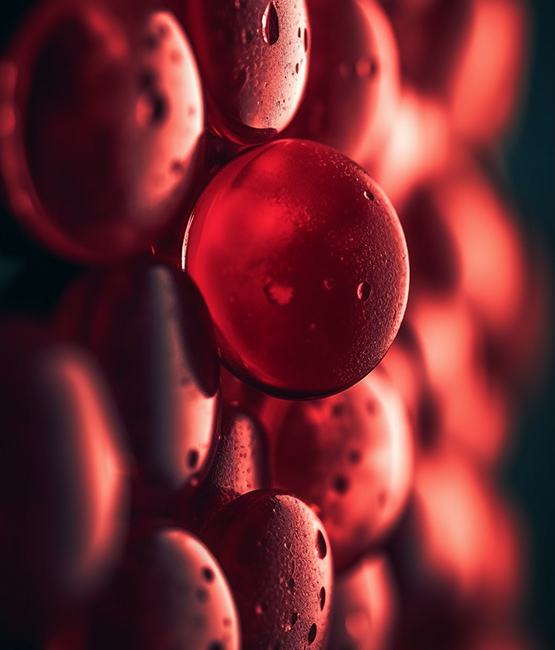XANTHOUMOL – UNE MOLÉCULE MIRACLE
DES PROPRIÉTÉS ANTI-INFLAMMATOIRES AUX PROPRIÉTÉS ANTI-CANCÉREUSES ET ANTI-NEURODÉGRADATIVES
Voir d'autres articlesRECHERCHE SUR LE XANTHOUMOL

L'inflammation est un processus naturel qui aide notre corps à combattre les infections et les blessures, mais lorsqu'elle persiste trop longtemps, elle devient problématique. L'inflammation chronique est à l'origine de nombreuses maladies, des maladies cardiaques au diabète en passant par la dépression.
Action du xanthohumol
Les effets du xanthohumol sont impressionnants, car il a la capacité de supprimer efficacement les processus inflammatoires dans l'organisme. Des études en laboratoire et chez l'homme ont montré que même de faibles doses de cette substance peuvent inhiber l'activité de régulateurs clés de l'inflammation, tels que la voie NF-κB et l'inflammasome NLRP3 [1], entraînant une réduction de la production de cytokines pro-inflammatoires et une amélioration des mécanismes antioxydants naturels des cellules [2]. Ainsi, le xanthohumol aide l'organisme à réduire l'inflammation chronique, à l'origine de nombreuses maladies, dont l'athérosclérose et le diabète de type 2.
Réduit l'inflammation
L'arthrose en est un exemple : le xanthohumol a inhibé la dégradation du cartilage lors d'études en laboratoire. Outre l'inhibition de la production de cytokines inflammatoires, le xanthohumol limite l'activation et le transfert du facteur C/EBPβ vers le noyau cellulaire, responsable de l'activation des gènes associés à la dégradation du cartilage. De plus, il augmente la production de collagène de type II et d'aggrécane, essentiels à la santé du cartilage, dont l'absence entraîne sa destruction [3].
ACTION DU XANTHOUMOL
GARDIEN DU GLYCOCALIX – LE BOUCLIER PROTECTEUR DES CELLULES
COMMENT LE XANTHOUMOL AIDE-T-IL À PROTÉGER LE GLYCOCALIX ?
Le mécanisme de dégradation du glycocalyx peut être comparé à l'action de « ciseaux moléculaires » coupant ses chaînes sucre-protéine. Parmi les enzymes importantes impliquées dans ce processus, on trouve :
PROBLÈMES CARDIOVASCULAIRES
BOUCLIER ANTIOXYDANT
TRAITEMENT DES COMPLICATIONS
LE POTENTIEL DE LUTTE CONTRE LE CANCER DU XANTHOUMOL
Le cancer est l'une des principales causes de décès dans le monde. Son développement et sa progression sont un processus complexe impliquant divers facteurs génétiques et environnementaux. Des études ont montré que le xanthohumol présente un large spectre d'effets anticancéreux grâce à des mécanismes moléculaires multi-cibles. Parmi ceux-ci, on peut citer:
Le xanthohumol active les principales voies apoptotiques en:
De plus, le xanthohumol agit sélectivement contre les cellules cancéreuses, montrant une plus grande toxicité envers elles que envers les cellules saines [30].
EXEMPLES DE CANCER POUR LESQUELS LE XANTHOUMOL A ÉTÉ UTILISÉ :
EFFICACITÉ DE L'UTILISATION DE LA CHIMIOTHÉRAPIE

Mécanisme de soutien de la chimiothérapie au niveau moléculaire
Ce que montrent les modèles
ACCOMPAGNEMENT DANS LES THÉRAPIES MÉDICAMENTEUSES
Le xanthohumol peut agir en synergie ou en complément de certains médicaments non chimiothérapeutiques, bien que les recherches menées jusqu'à présent se soient principalement concentrées sur des substances et des effets pharmacologiques spécifiques. Il a été démontré que le xanthohumol renforce l'activité de certains médicaments non stéroïdiens et antituberculeux et améliore la sécurité du traitement grâce à ses propriétés anti-inflammatoires et antioxydantes, sans provoquer d'interactions indésirables significatives avec les médicaments courants.
En résumé, le xanthohumol est considéré comme un adjuvant sûr dans le traitement de nombreuses maladies, notamment infectieuses, cardiaques et métaboliques. Il contribue à améliorer l'efficacité des médicaments et protège l'organisme de certains effets secondaires, ce qui peut améliorer la qualité de vie des patients pendant le traitement.
ACCOMPAGNEMENT DANS LE TRAITEMENT DE L'ÉPILEPSIE
AVANTAGES SUPPLÉMENTAIRES POUR VOTRE CERVEAU
RECONSTRUIRE ET AMÉLIORER LE SYSTÈME DIGESTIF
Nos intestins ne sont pas seulement le siège de la digestion des aliments, mais aussi un véritable « second cerveau » qui influence notre santé, notre humeur et notre état d'esprit. Ils abritent des milliards de bactéries qui composent le microbiote intestinal, lequel joue un rôle crucial dans le maintien de la santé de l'organisme. Le xanthohumol est un hôte idéal pour ces micro-organismes bénéfiques, démontrant un potentiel thérapeutique important pour restaurer et améliorer le système digestif, en particulier les intestins. La recherche met en évidence ses mécanismes d'action multidimensionnels [82], [83], [84].
ESSAIS CLINIQUES SUR LA MALADIE DE CROOHN
Des essais cliniques sont actuellement en cours, dans lesquels le xanthohumol est administré à des patients atteints de la maladie de Crohn active. L'étude XMaS porte sur un maximum de 32 patients recevant 24 mg de xanthohumol par jour pendant 8 semaines. Les biomarqueurs de sécurité, les marqueurs inflammatoires, la fonction plaquettaire, l'activité de la maladie (CDAI), la composition du microbiote fécal et les métabolites du xanthohumol sont surveillés [88].
ACTION DANS LA COLONITE
Dans un modèle murin de colite induite par le DSS, le xanthohumol a significativement amélioré la maladie. Il a protégé l'épithélium intestinal des lésions, réduit la production de cytokines inflammatoires et le stress oxydatif, et bloqué l'action des enzymes et des facteurs impliqués dans l'inflammation, tels que la cyclooxygénase-2 et la voie NF-κB [89].
IMPACT SUR LA SANTÉ OSSEUSE DES MALADIES INTESTINALES
ACTION GASTROPROTECTRICE
SÉCURITÉ D'UTILISATION DU XANTHOUMOL
LA RECHERCHE EST TOUJOURS EN COURS
REMARQUES



